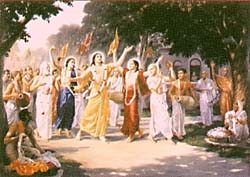






Now hear, brothers, of the places that I will describe within the sixteen krosas of Navadvipa-dhama.
There eternally exists sixteen rivers within the sixteen krosa area of Navadvipa. On the eastern bank of the main Ganges are four islands and on the western bank there are five. The different tributaries of the Granges surround these islands and give the dhama its splendor. The main Ganges always flows in the middle, while other pious rivers flow in various tributaries. Near the Ganges flows the beautiful Yamuna, and the Sarasvati flows within another river. East of the Yamuna are the long streams of the Tamraparni, the Krtamala, and the Brahmaputra. The Sarayu, Narmada, Sindhu, Kaveri, Gomati, and Godavari flow swiftly throughout the breadth of Navadvipa. All these rivers intersect to form the nine different islands of Navadvipa.
Following the desires of the Lord, sometimes the streams dry up, and then again by His wish they flow with water; by the Lord's wish sometimes places become covered with water, and by His wish they again become visible. In this way the dhama endlessly enacts its lila, but the same dhama remains always manifest to the fortunate living entity. If a devotee has an acute desire in his heart, all the islands and rivers will be visible. By devotion, the dhama is sometimes visible in dreams, meditation, or to the naked eye.
The island which lies at the junction of the Ganges and Yamuna is known in the sastras as Antardvipa. Within Antardvipa lies the holy sanctuary of Mayapur, where Lord Caitanya appeared. Know, devotees, that Mahavana. in the center of Goloka, is none other than Mayapur of Navadvipa.
Svetadvipa, Vaikuntha, Goloka, and Vrndavana reside in Navadvipa at all times. By the order of Gauracandra, the seven holy cities: Ayodhya, Mathura, Maya (Haridvara), Kasi, Kanci, Avanti (Ujjain), and Dvaraka, are always present in their own places within Navadvipa. The city of Maya, at Gangadvara, has its original form as Mayapur in Navadvipa-dhama, The glories of this particular place are profusely sung in the scriptures.
That person who once visits Mayapur is easily freed from the bondage of maya One who walks throughout Mayapur is freed from the influence of maya and the repetition of birth.
North of Mayapur lies Simantadvipa. Sadhu and Sastra have explained the rules of parikrama. After having darsana of Mayapur in Antardvipa, learned devotees go to Simantadvipa. Next one should go south of Mayapur to Godrumadvipa, then one should joyfully go to Madhyadvipa. After seeing these four islands on the east bank, one should reverently cross the Ganges. Having walked around Koladvipa at leisure, then take darsarna of Rtudvipa. After seeing the most beautiful Jahnudvipa, go see Modadrumadvipa and then Rudradvipa. Then again cross the Ganges, and walk back to Mayapur. There, respectfully enter the temple of Jagannatha Misra and Sacidevi and take darsana of the Lord. This is the procedure of parikrama for all times. One who follows this practice will obtain unlimited happiness.
Everyone considers the best time for performing parikrama is from the tithi of Makara-saptami up to the full moon, or purnima of Phalguna. After finishing parikrama, fortunate persons take darsana at Mayapur on the birthday of Lord Caitanya. Nitai and Caitanya bestow Their mercy and the shade of Their lotus feet on those persons, who thus attain the qualification to execute devotional service.
Briefly I have described the rules for parikrama and now I will describe everything in detail. Therefore, please listen. Whoever walks around the one hundred sixty-eight miles of Gaura mandala will quickly obtain the treasure of gaura-prema.
Desiring to obtain the shade of the lotus feet of Jahnava and Nitai, Bhaktivinoda reveals these truths.


